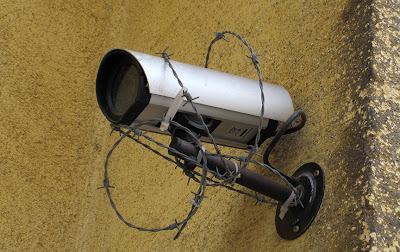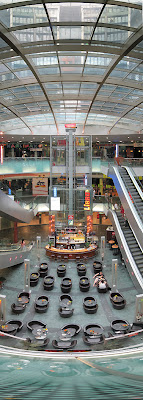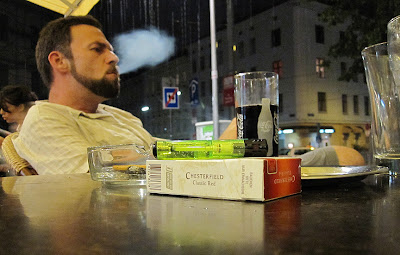Today marked the end of my trip. I would spend a few hours surveying alleys near Hotel Lucia in a final search for Viennese street art before catching the train back to Munich. The morning's photographic odyssey inspired some strange encounters, as folks standing near a piece of throwaway stencil graffiti would look askance at my studied efforts to compose and crop my shots. The act of taking photos of local commonplaces produces a strange effect, one requiring a tourist to become notably uncultured in foreign lands, just to appear cultured for friends back home. I delighted in my situation's absurdity, even as the minutes ticked away before my train would depart.
 |
| Vienna street art |
In my midmorning search for a meal, I would not seek a "peak experience." I was mildly hungry but in no mood to hop subway stations of some cultural pilgrimage prescribed by my guidebook. I would simply sit down at a place that seemed right for me. Fortunately, finding a bar or cafe in Vienna is just as easy as finding a thrilling piece of baroque architecture or pitying an exasperated visitor flipping through a guidebook. In Vienna, they're everywhere. I just wanted some wiener schnitzel and a beer. And just like that, I entered a modest place where I knew I could enjoy an outdoor meal. Stepping up to order, though, something marvelous happened.
As I fumbled through the necessary greetings and details of my order, I was addressed in
German, not in polite but somewhat condescending English. With strategically employed gestures and a smattering of rightly timed phrases, I managed a couple volleys of communication before my secret was revealed. Of course I do not know the language. But something about my demeanor pegged me as less of an outsider than normal. The woman at the counter smiled warmly and offered to bring my
bier to a table outside. Before long, I was riding the train back to Munich, full, content, and ready for home.
There's something wonderful about dipping cookies in a melange and watching the countryside roll by. Unfortunately I was sitting next to the one annoying dude, a would-be hipster with requisite three-day-old facial hair and a penchant for interrupting his German with "global" words like "Facebook" and "PDF" into his iPhone (of course it was an iPhone). This guy, a lamoid who didn't even look up when the conductor came by to punch his ticket, must have been the only Austrian who missed the memo that polite folks don't yell into their cell phones on trains. I tuned out my train nemesis with Thelonious Monk's "Ruby, My Dear."
Pulling into Salzburg, a brief stop on the way to Munich, I grew intrigued by the variances in explanations about our location. In German, the conductor seemed to wax eloquently about the place, describing important landmarks, explaining points of historical interest -- maybe telling stories about his kids, for all I knew. In English, he merely said, "Ladies and gentlemen, we are in Salzburg." No matter, loser-hipster-guy departed, presumably in search of a discothèque filled with bouncy teens and droning beats. He left his table covered in the trash of his various espressos and foil-covered snacks. I almost thought I heard a sigh of relief from a few other passengers (or maybe that was just me).
Rolling back to Munich, past those small towns dotted with tall church spires that jolt away from the land like exclamation points (German language speakers, at least official ones, seem drawn to exclamation points) I sipped a Budweiser
Budvar, supposedly a "Czech important lager" that was offered as an alternative to an Austrian
bier that I was told to be insufficient. The word "original" was scrawled atop the crookedly glued sticker, though to my shame, I realized that it'd been years since I downed an American Budweiser. Whatever this stuff was, I could hardly tell the difference.
On this trip, efforts to find real experiences, something like Walter Benjamin's idea of "aura," invariably seemed forced, fake. Only when I eased into things, settled into a less pressured vibe of "getting it right," did I catch glimpses of the real thing. Still the question remains: what is the purpose of travel? Truth or pleasure? Presumably one ventures afar in order to learn something new, so long as the thing beheld is true. Yet I increasingly side with those who admit trepidation at the whole ideal of "the real." For every moment of truth, there is always one who knows more, a self-styled expert who points out the fakery of any place, or at least the fakery of your own search.
So I wrap up my trip report on the train to Munich where I will stay the night before departing for SFO and home. I'm devouring a slice of
Schokonusstorte and sipping some middling whiskey. Tomorrow at the airport I will order an
Airbrau and a
Henkersmahlzeit (a "hangman's lunch" composed of bread, water, and a cigarette). Now I gaze over the terrain with a combination of wide-eyed amazement and practiced ennui. I sat in a cafe today, leaving the last of my foolishly purchased Chesterfield cigarettes stubbed out in an ashtray. I practiced the art of being a local, one who knows. For a moment, I was that person,
I was there. But always I was still me, a guy who stared awestruck at the vacation slideshows of others when I was a kid, one who never thought he'd travel to places like this. Today I was in Vienna; tomorrow it's back to Starbucks.
Part of the Salzburg seminar, I'm told, is to create citizens of the world. And certainly I've seen a bit more of the world now that I've come here. Yet truthfully I wonder how much of my citizenship is solely vested in souvenirs and a few good stories. Perhaps somewhere, maybe in the next train, there's a person who knows all the inside jokes, one who knows all the cool places that are lost to the travel-guide writers. Maybe he's wrapping a fellow traveler in the pleasurable embrace of a story far too clever to retell. One that can only be experienced. I am not that person. But I have been somewhere new these past few days. I've met some amazing people and seen some wonderful things.
 |
| Indeed.... |
That is enough for today.
Day 11 | Start Over






















































